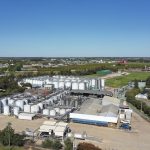By Andrew Cottell, Parish Hill Wines, Adelaide Hills, South Australia
First published in the January/February 2018 issue of the Wine & Viticulture Journal

 We grow Dolcetto at our Parish Hill Vineyard, in the Piccadilly Valley, in the Adelaide Hills.
We grow Dolcetto at our Parish Hill Vineyard, in the Piccadilly Valley, in the Adelaide Hills.
Our vineyard is at an altitude of around 500 metres on a steep slope with a west-northwest aspect that picks up a lot of afternoon sunlight and heat to enhance ripening. This is in contrast to the other side of the valley that faces mainly east and gets less solar radiation. The vineyard receives an annual rainfall of 1100mm and has a mean January temperature of 19.5°C.
Our vines are Matura selections from Chalmers Nursery and were planted in about 2005 on Richter 110 rootstocks. After looking at the performance of all the Matura clones from Chalmers’ trials we chose Matura clones 3, 4 and 5 as they achieved the highest and earliest Baume, meaning they would be most likely to fully ripen between 12.5° to 13° here in our cooler site, which they do.
Prior to this we trialed clones CN 69 an CN 275 which were okay but had bigger bunches, ripened later than their Matura counterparts and made a less intense wine.
Our rows are 2.3 metres apart and have a 1.2 metre vine spacing. Vines are VSP cane pruned to a single cane of six to eight buds on a cordon wire at 900mm. The canopy is held in four sets of foliage wires to give a tall canopy to maximise photosynthesis.
Dolcetto seems to get powdery mildew just after harvest but otherwise seems no more susceptible to disease than any other of the varieties we grow and is not treated any differently.
Dolcetto is not a vigorous grower and can be a bit weedy and brittle with fragile buds and multiple shoots per bud at budburst. Many buds give two or three shoots that need to be hand thinned. We don’t do much shoot or bunch thinning apart from that as the crop always seems about right.
Bunches and berries seem to vary in size.
The leaves of Dolcetto show characteristic red veins and red petioles which can be quite pretty. In autumn, Dolcetto has attractive reddish/orange autumn foliage which makes the vines stand out from the rest of the mainly yellow autumn colours of the vineyard. Leaf shape varies from sharp tri-lobed lanceolate to more like a Chardonnay leaf.
Budburst is about five days after Nebbiolo, flowering occurs in the third week of September, veraison in the middle of February and harvest in the third or fourth week of March.
The vines yield six to seven tonnes per hectare at harvest when grapes are handpicked into crates.
The timing of harvest is based mainly on flavour which seems to develop late in our vineyard even though the sugars seem good. We get sweet flavours of fruit cake/ Christmas pudding.
Dolcetto is prone to berry drop when mature so this would be a potential problem for machine harvesting.
The wine is made conventionally: crushed, destemmed and inoculated with a commercial yeast which changes from year to year. No acid additions are needed.
Macerating and colour enzymes are not used as Dolcetto gives up most of its colour in the first few days and is only left on skins for a week after fermentation.
A malolactic culture is added near the end of the ferment while warm and after a week on skins post-ferment is pressed into stainless steel and kept at 20°C until malolactic fermentation is finished. MLF is rapid as Dolcetto is not only low in tartaric acid but also low in malic acid.
The alcoholic ferment is kept at 25-30°C. Dolcetto, like Nero d’Avola, can sometimes be reductive and smelly during fermentation and is given several aerating pump-overs and rack-and-returns if needed.
After MLF is finished, PMS is added and the wine monitored over the next few months with several rackings. The finished wine usually has a final pH of 3.5 to 3.6 and is bottled unfined and unfiltered in November of the same year.
Dolcetto is not a wine for long ageing and is best while young and fresh over the first two to three years, although if made at 14° ABV and aged in oak it might.
We don’t blend any other varieties with our Dolcetto as it is easy to mask its true varietal characters.
Some producers use Dolcetto for sparkling wine or as a component of a rosé so it has some versatility even for a pet-nat.
The wine itself shows intense violet and ruby colours when young and fragrant and spicy aromatics. Other features include cherry, chocolate, ink, leather, marzipan, almond, dark plums and violets. Dolcetto produces juicy ripe fruit with medium to lightweight tannins.
The home of Dolcetto is the Piedmont in northwest Italy where it co-exists with Nebbiolo and Barbera. To the east it’s planted in Lombardy and to the south in Liguria, where it’s called Ormeasco, as well as in Sardinia.
Because of increased international interest in Nebbiolo many Italian growers are replacing their Dolcetto vineyards with Nebbiolo, so much so that the hectares of Dolcetto have decreased 18% between 2000 and 2010.
I doubt there are any close homoclimes in Australia; the continentality of Piedmont is much greater than at our site.
Although not many vineyards of Dolcetto exist in Australia it has been here a long time, first introduced by James Busby into the first Sydney Botanic Gardens. Later, when that collection was dispersed, some found its way to the Adelaide Plains and Barossa Valley where it was probably used in fortified wine production.
The oldest plantings are at Best’s Great Western, in Central Victoria, where it was planted in the late 1800s.
Dolcetto is a good everyday drinking wine, even chilled in the summer, and goes well with food such as pasta, pizza, antipasti and prosciutto for example.
Dolcetto has traditionally been downgraded by wine enthusiasts, critics, writers and opinion makers as a lesser wine than its companions Barbera and Nebbiolo but I think it’s time they took a break from serious Barolo and Barbaresco sniffing and enjoyed a glass of Australian or Italian Dolcetto, reset their thinking and become an advocate for the variety.
FOR FURTHER INFORMATION
Bastianich, J. and Lynch, D. (2002) Vino Italiano: The Regional Wines of Italy. Clarkson Potter.
Cernilli, D. and Sabellico, M. (2001) The New Italy: A Complete Guide to Contemporary Italian Wine. Wine Appreciation Guild.
D’Agata, I. (2014) Native Winegrapes of Italy. University of California Press, Berkerley, United States
Hyland, T. (2013) Beyond Barolo and Brunello: Italy’s Most Distinctive Wines. Createspace.
McKay, A.; Crittenden, G.; Hardie, J. and Dry, P. (1999) Italian winegrape varieties in Australia: exploring the potential of Barbera, Nebbiolo, Sangiovese, Vernacci di San Giminano, Dolcetto & Arneis. Winetitles, South Australia.
DOLCETTO

By Peter Dry Emeritus Fellow, The Australian Wine Research Institute
BACKGROUND
Dolcetto (doll-CHET-oh) literally means ‘little sweet one’—perhaps a reference to its low berry acidity. It was first mentioned in the late 16th century in southern Piedmont, in north-west Italy, where it is widely grown—although the area under vine has declined in recent times at the expense of Barbera. Today it is most important in the provinces of Cuneo, Alessandria and Asti. Dolcetto is also grown in Liguria, Lombardy and Umbria. Synonyms include Nibièu, Nibiò (Lombardy, Piedmont) and Ormeasco (Piedmont, Liguria). The global area in 2010 was 6333ha (down 12% since 2000) of which Italy has 97%. In Piedmont, Dolcetto comprises 13% of the total planted area of Piedmont where it is used as a single variety in many DOCs, e.g., Asti, Alba, Langhe and Monferrato, and at least one DOCG, Dogliano. It is also authorised as a blending partner with Barbera in several Piedmont DOCs. There is also a white Dolcetto Bianco but this is not genetically related to the black-fruited Dolcetto. There is a small area in USA (California, Oregon and Washington). Dolcetto has been grown in Australia for many years; in the 1970s most of the so-called ‘Malbec’ in Victoria was discovered to be Dolcetto. Despite the small planted area, there are at least 40 wine producers in Australia, mainly in Victoria and SA (16.6ha).
VITICULTURE
Budburst is mid-season and maturity is early, thus making it suitable for the coolest sites in Piedmont where Barbera and Nebbiolo do not ripen satisfactorily. Vigour is moderate with semi-erect growth habit. Bunches are medium and well-filled to compact with small to medium berries. Yield is moderate and regular. Wines are said to lack intensity if yield is excessive. Spur pruning is used in Australia. Bunches are susceptible to bunch rot. There are at least seven clones available in Australia.
WINE
Dolcetto wines have medium colour with light to medium body, and are soft, round and fruity. They may be best consumed when young. Descriptors include cherry, liquorice, almonds, savoury and spice. Its unusual combination of low acidity and high tannin requires careful blending. Dolcetto is mainly used for varietal wines in Australia, but can also be a useful blending partner, e.g., with Barbera in Italy and Lagrein in Australia.




















